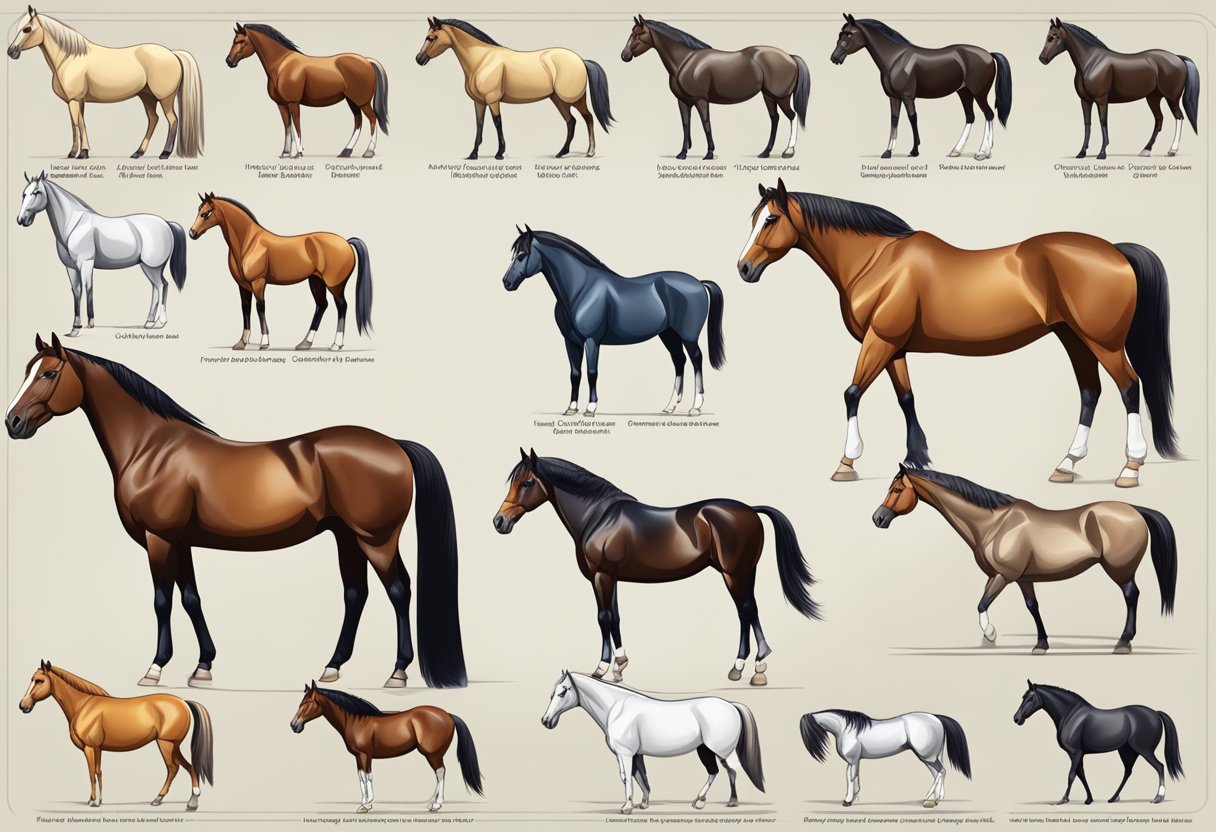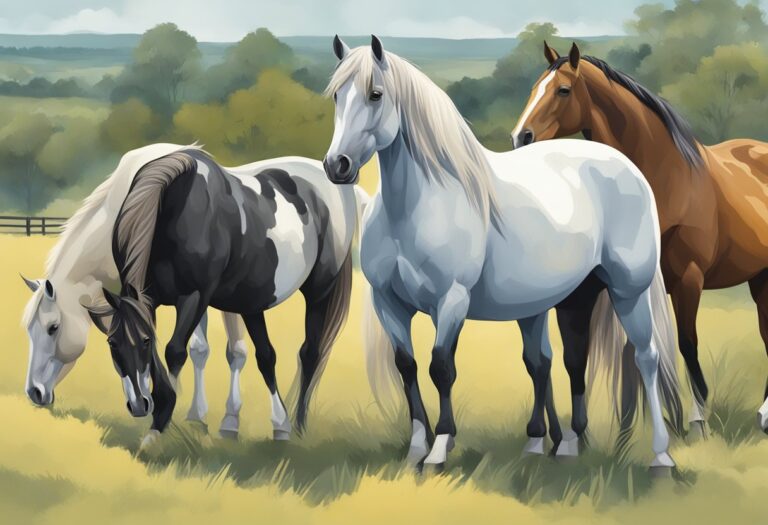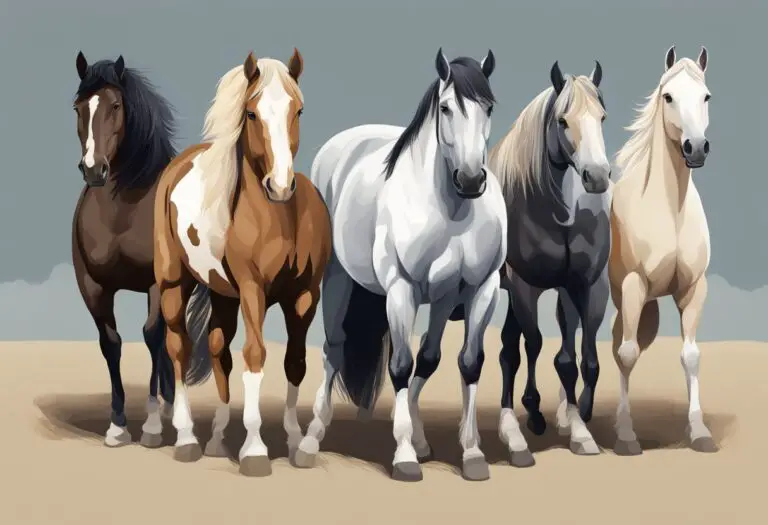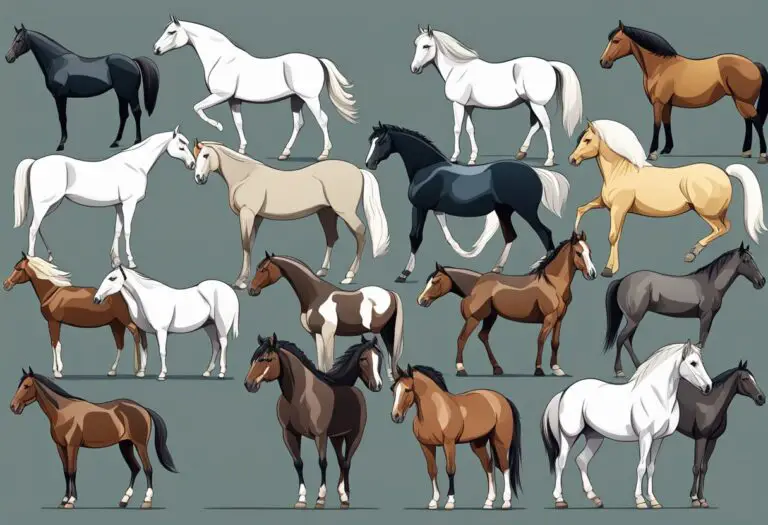How to Distinguish Between Horse Breeds? A Clear Guide
Horses are one of the most majestic and beloved animals in the world. With over 300 different breeds, it can be difficult to distinguish between them. However, understanding the differences between horse breeds is crucial for anyone who wants to work with or own horses.
One way to distinguish between horse breeds is by their physical characteristics. Different breeds have distinct physical features such as height, weight, body shape, and coat color. For example, the Arabian horse is known for its dished face, high-set tail, and fine coat, while the Clydesdale is known for its large size, feathered legs, and distinctive bay coat color. By learning to recognize these physical characteristics, one can easily identify different horse breeds.
Another way to distinguish between horse breeds is by their temperament and behavior. Different breeds have different personalities and are suited for different activities. For example, Thoroughbreds are known for their speed and are often used for racing, while Quarter Horses are known for their versatility and are commonly used for ranch work and rodeos. By understanding the temperament and behavior of different horse breeds, one can make informed decisions about which breed is best suited for their needs.
Understanding Horse Breeds

Breed Classifications
Horse breeds can be classified into various categories based on their physical attributes, temperament, and intended use. The most common classifications include light horses, draft horses, and ponies.
Light horses are typically used for riding, racing, and other athletic pursuits. They are known for their agility, speed, and endurance. Examples of light horse breeds include Thoroughbreds, Arabians, and Quarter Horses.
Draft horses, on the other hand, are larger and more muscular than light horses. They are often used for heavy work such as plowing fields or pulling carts. Examples of draft horse breeds include Clydesdales, Percherons, and Belgians.
Ponies are smaller than both light and draft horses and are often used for children’s riding or driving. They are known for their hardiness and intelligence. Examples of pony breeds include Shetlands, Welsh Ponies, and Connemaras.
Breed History and Origins
Horse breeds have been developed over centuries through selective breeding for specific traits. Many breeds have their origins in specific regions or countries, and their physical characteristics reflect the environment and intended use of the breed.
For example, the Arabian horse originated in the Middle East and is known for its endurance, speed, and beauty. The Thoroughbred, which was developed in England, is known for its speed and athleticism and is commonly used for racing.
Other breeds, such as the American Quarter Horse, were developed in the United States for specific purposes such as ranch work or rodeo events.
Understanding the history and origins of different horse breeds can help horse enthusiasts appreciate their unique qualities and better understand their intended use.
Physical Characteristics

Horses come in a variety of breeds, each with distinct physical characteristics. Understanding these characteristics is essential in distinguishing between different breeds.
Coat Colors and Patterns
One way to distinguish between horse breeds is by their coat colors and patterns. Horses can come in a range of colors, including black, brown, white, chestnut, and gray. Some breeds, such as the Appaloosa, have distinctive coat patterns, such as spots or speckles.
Body Types and Conformation
Another way to distinguish between horse breeds is by their body types and conformation. Horses can have a range of body types, including light, medium, and heavy. The conformation of a horse refers to its physical structure, including the shape of its head, neck, and legs. Some breeds, such as the Thoroughbred, have a lean and athletic body type, while others, such as the Clydesdale, have a heavier and more muscular build.
Distinctive Markings
Distinctive markings are another way to distinguish between horse breeds. Some breeds, such as the Arabian, have a distinctive dished profile and a high-set tail. Others, such as the Friesian, have a long, flowing mane and tail. Some breeds, such as the Paint Horse, have distinctive markings on their coat, such as patches of color or a bald face.
By understanding these physical characteristics, it is possible to distinguish between different horse breeds and appreciate the unique qualities of each breed.
Behavioral Traits

Temperament
One of the most important factors to consider when distinguishing between horse breeds is their temperament. Different breeds have distinct personality traits, which can affect their behavior and suitability for various activities.
For example, the Arabian horse is known for its high spirit and intelligence. They are often used in endurance riding and other sports that require stamina and agility. On the other hand, the Clydesdale horse is known for its calm temperament and is often used for farm work and carriage driving.
Other breeds, such as the Thoroughbred and Quarter Horse, have a mix of traits that make them suitable for a variety of activities. Thoroughbreds are known for their speed and athleticism, making them popular for racing and jumping. Quarter Horses, on the other hand, are known for their versatility and are used for everything from ranch work to rodeo events.
Gait Patterns
Another way to distinguish between horse breeds is by their gait patterns. Different breeds have distinct ways of moving, which can affect their performance in various activities.
For example, the Tennessee Walking Horse is known for its unique “running walk” gait, which is smooth and comfortable for riders. This makes them popular for trail riding and other leisurely activities. The Paso Fino, on the other hand, has a four-beat gait that is very smooth and comfortable, making them popular for endurance riding and other long-distance events.
Other breeds, such as the Thoroughbred and Quarter Horse, have a more traditional “trot” and “canter” gait. These gaits are suitable for a variety of activities, from racing to jumping to ranch work.
By understanding the behavioral traits and gait patterns of different horse breeds, riders can choose the best horse for their needs and ensure a successful partnership.
Genetics and Breeding

Bloodlines
One of the key factors in distinguishing between horse breeds is their bloodline. A horse’s bloodline is determined by its pedigree, which traces its ancestry back several generations. This information can be very useful in identifying a horse’s breed, as certain breeds are known for their distinct bloodlines.
For example, the Thoroughbred breed is known for its strong ties to the Darley Arabian, Byerly Turk, and Godolphin Arabian bloodlines. Similarly, the Quarter Horse breed is known for its strong ties to the bloodlines of Peter McCue and King.
Inherited Traits
In addition to bloodlines, inherited traits can also be used to distinguish between horse breeds. These traits are passed down from generation to generation and can include physical characteristics, temperament, and performance abilities.
For example, the Arabian breed is known for its distinctive head shape, high-set tail, and endurance capabilities. The Clydesdale breed, on the other hand, is known for its large size, feathered hooves, and gentle temperament.
Breeding also plays a significant role in determining a horse’s traits. Breeders carefully select horses with desirable traits to produce offspring with those same traits. This is known as selective breeding and can be used to create new breeds or improve existing ones.
Overall, understanding genetics and breeding is crucial in distinguishing between horse breeds. By studying bloodlines and inherited traits, one can gain a deeper understanding of the unique characteristics that make each breed distinct.
Performance and Uses

Sporting Breeds
Sporting breeds are known for their athleticism and agility, making them ideal for activities such as racing, jumping, and hunting. These breeds are often high-energy and require regular exercise to maintain their physical and mental health. Examples of sporting breeds include Thoroughbreds, Arabians, and Quarter Horses.
Work Breeds
Work breeds are often larger and stronger than other horse breeds, making them ideal for tasks such as plowing fields, pulling carts, and carrying heavy loads. These breeds are known for their endurance and strength, as well as their ability to work for long periods of time without tiring. Examples of work breeds include Clydesdales, Percherons, and Belgian Drafts.
Companion Breeds
Companion breeds are typically smaller and more docile than other horse breeds, making them ideal for activities such as riding lessons, therapy programs, and recreational riding. These breeds are often gentle and easy to handle, making them suitable for riders of all ages and skill levels. Examples of companion breeds include Shetland Ponies, Welsh Ponies, and Miniature Horses.
When choosing a horse breed, it is important to consider the intended use and the horse’s individual temperament and personality. By understanding the characteristics and traits of different horse breeds, riders can make an informed decision and select a horse that is well-suited for their needs.
Breed Registries and Associations

Breed registries and associations are organizations that maintain records of the pedigrees and bloodlines of different horse breeds. These organizations are essential to the identification and preservation of horse breeds. They also provide a wealth of information about the breed’s history, characteristics, and breeding standards.
One of the most well-known breed registries is the American Quarter Horse Association (AQHA). This organization maintains the pedigree records of quarter horses, one of the most popular horse breeds in the United States. The AQHA also sets breeding standards for quarter horses, ensuring that the breed’s characteristics are maintained over time.
Another prominent breed registry is the Arabian Horse Association (AHA). This organization maintains the pedigree records of Arabian horses, one of the oldest and most recognizable horse breeds in the world. The AHA also hosts shows and events that showcase the beauty and athleticism of Arabian horses.
Other breed registries and associations include the Thoroughbred Owners and Breeders Association (TOBA), the Appaloosa Horse Club (ApHC), and the United States Equestrian Federation (USEF). Each of these organizations serves a unique purpose in the horse industry, from promoting specific breeds to regulating horse shows and competitions.
When researching horse breeds, it is essential to consult breed registries and associations to ensure accuracy and reliability. These organizations are a valuable resource for anyone interested in learning more about horse breeds and their unique characteristics.
Conservation and Preservation

Preserving horse breeds is essential for maintaining genetic diversity and preventing the loss of valuable traits. Many horse breeds have been developed for specific purposes, such as racing, ranch work, or carriage driving. Some breeds have become rare due to changes in agriculture and transportation, while others have been threatened by war, disease, or neglect.
Conservation efforts can help protect rare breeds and prevent their extinction. These efforts may include breeding programs, genetic testing, and education programs. The goal is to maintain a healthy population of horses with diverse genetics and desirable traits.
One example of a conservation success story is the Przewalski’s horse, which was once extinct in the wild. Through breeding programs and reintroduction efforts, the population has been restored to over 1,500 individuals. Other rare breeds, such as the Caspian horse and the Suffolk Punch, continue to face challenges and require ongoing conservation efforts.
Preservation of horse breeds also involves maintaining their unique characteristics and traits. Breed standards are established by breed organizations to describe the ideal physical and behavioral traits of each breed. These standards help ensure that horses are bred for their intended purpose and maintain their distinctive qualities.
Overall, conservation and preservation efforts are crucial for maintaining the genetic diversity and health of horse breeds. By protecting rare breeds and maintaining breed standards, we can ensure that these magnificent animals continue to thrive for generations to come.







